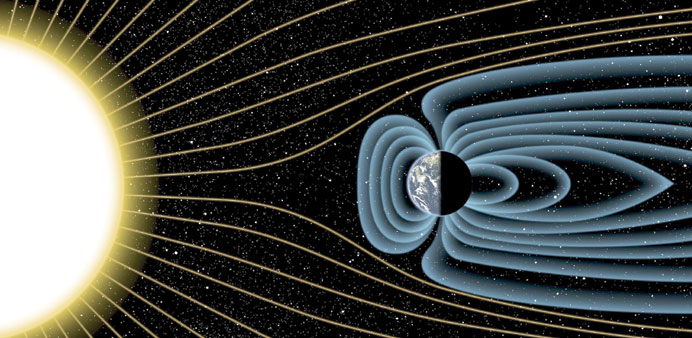An artist’s depiction of Earth’s magnetic field deflecting high-energy protons from the sun 4bn years ago, is shown in this image released yesterday. The relative sizes of the Earth and Sun, as well as the distances between the two bodies, are not drawn to scale in this drawing.
Reuters/Washington
Earth’s magnetic field has been a life preserver, protecting against relentless solar winds, streams of charged particles rushing from the Sun, that otherwise could strip away the planet’s atmosphere and water.
“It would be a pretty barren planet without it,” said University of Rochester geophysicist John Tarduno.
But there has been debate among scientists about when this vital shield generated by Earth’s liquid iron core formed.
Researchers yesterday said evidence entombed in tiny crystals retrieved from the outback of western Australia indicates the magnetic field arose at least 4.2bn years ago, much earlier than previously believed.
Previous research had estimated the field originated about 3.5bn years ago, roughly a billion years after Earth’s formation. The new study shows Earth was protected by its magnetic field beginning very early in its history.
“The solar wind would have been much more intense 4bn years ago,” said Tarduno, who led the study published in the journal Science. “Its erosional capability was perhaps 10 times greater than it is today. Without a magnetic shield, you would have this tremendous possibility of eroding the atmosphere and removing water from the planet.”
The study focused on a mineral called magnetite contained inside ancient zircon crystals from Australia’s Jack Hills. Magnetite preserves a record of magnetic field strength at the time the mineral was trapped in the zircon.
The researchers examined magnetite in zircon crystals measuring about one-tenth to two-tenths of a millimetre in size and dating from about 3.2bn to 4.2bn years ago, and concluded Earth possessed a magnetic field during that entire period.
Without a magnetic field, it may have been difficult for life to emerge on Earth as it has.
“Knowing the initiation of the magnetic field has implications for habitability conditions of early Earth,” said University of Rochester geologist Rory Cottrell.
“Finding suitable geologic material to measure deep time is a challenge in and of itself. Zircon grains from Western Australia may be one way to obtain such information about the early magnetic field,” Cottrell added.
Only two of the solar system’s rocky planets, Earth and Mercury, possess a magnetic field. Mars previously had one, but it dissipated about 4bn years ago.
“Mars once had a much denser atmosphere and oceans,” said Tarduno.
The magnetic field’s disappearance exposed Mars to solar winds that may have peeled off the atmosphere and water, leaving the planet desolate.
Astronomers find star with three super-Earths
Astronomers said yesterday they had found a planetary system with three super-Earths orbiting a bright, dwarf star - one of them likely a volcanic world of molten rock.
The four-planet system had been hiding out in the M-shaped, northern hemisphere constellation Cassiopeia, “just” 21 light years from Earth, a team reported in the journal Astronomy & Astrophysics.
It comprises four planets - one giant and three super-Earths orbiting a star dubbed HD219134. Super-Earths have a mass higher than Earth’s but are lighter than gas giants like Neptune, Saturn or Jupiter. They can be made of gas, rock, or both.
The planet with the shortest orbit, HD219134b, zips around every three days, and has now been observed transiting across the face of its star as seen from the vantage point of Earth.
Measurements from the ground and with Nasa’s Spitzer space telescope showed its mass was 4.5 times higher than Earth’s, and that it was 1.6 times larger.

